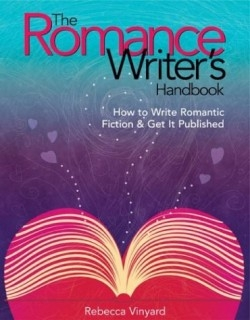The Romance Writer's Handbook
How to Write Romantic Fiction and Get It Published
There are some facts that writers of all genres should know: about half of all mass-market novels sold are romantic fiction; rough figures indicate that only one in 50,000 would-be writers will sell a book, and only one writer in 100 who sells a book will actually make a living at writing. With those facts firmly established, the author still manages to write an upbeat book full of advice on writing a romance novel in a market that has become increasingly impenetrable.
Drawing on the expertise of published authors in several romance sub-genres, Vinyard has compiled essays on different aspects of romance writing and organized them into an easy-to-read, easy-to-follow book. She starts with the basics of character and plot and works through publishing options, giving a nod to electronic as well as traditional publishing.
The chapter on manuscript preparation, something that many first-time writers don’t think about, is clear and to the point. A properly prepared manuscript is vitally important, and though Vinyard states her personal preferences, she reports the industry standard, which should be followed.
Vinyard, who is a journalist, romance novelist, and mistress of the popular Romance Central website, wrote some of the chapters; others were penned by multi-published authors. There are also interviews in the back of the book, where best-selling authors tell their success stories and offer tips-as well as hope-to those starting the journey of publishing.
Some of the best sections emphasize the basic elements of writing common to all books. With good cheer, Vinyard talks about passive and active voice, effective dialogue, complex characterization, and punctuation, among other topics.
Discussing dialogue, Vinyard points out that good dialogue moves the plot forward, or reveals character … preferably both. Though this is especially important in romantic novels, which are character-driven, it is also vital in all other fiction, as the author exemplifies in an excellent passage on different types of conflict.
“What does your character want?” Vinyard asks early on, showing that character motivation is the backbone of story. She offers advice on getting started, and suggests that a blocked writer turn to research. While researching, writers can stumble across an idea that gets them going again. Research also help writers more clearly visualize the era, character, and setting they are writing about, which translates into a more vivid picture for the reader. Vinyard makes the point that research isn’t only for books set in the past; contemporary fiction requires a lot of research, too.
The “rule of three” is an interesting, innovative concept that writers can use to describe a scene and also hone their skills of observation. She gives an example of how to describe a room: by limiting the number of images to three, a writer has to pick out details that work the hardest, the “telling” details. This prevents over-writing of description and forces the writer to think about what best reveals a character’s personality.
The section on acquiring an agent contains a score sheet for rating prospective agents, a clever way of bringing home the point that the author-agent relationship is a two-way street: both parties have to get their needs met. Vinyard includes information on creating an author website, and tips on writing query letters and synopses.
Vinyard and her co-authors are gentle defenders of the romance genre, pointing out, without being didactic, the misconceptions that have plagued the genre since it boomed in the 1980s. A chapter called “A Community for Writers” contains information on the Romance Writers of America, the largest group of genre writers in the world, with over 8,000 members. The organization and local chapters around the world sponsor numerous workshops dedicated to helping unpublished romance writers sharpen their writing skills.
In keeping with the romance genre, there is a chapter on writing love scenes, with the practical advice on writing what’s comfortable. Two chapters list archetypes for heroes and heroines, with some remarkable insights into the characters who often appear in romantic fiction.
With the concise sentences one would expect from a journalist, and plenty of white space, the book is an easy read. Vinyard has put a lot of thought into breaking the complexities of a book into easy-to-swallow tidbits; she companionably points would-be writers in the proper direction. The book is designed for beginners, and does an excellent job of walking a new writer through the basics of good writing and the business end of publishing. This handbook for new writers is also an enjoyable brush-up on writing romances for “older” authors.
Reviewed by
Carolyn Haines
Disclosure: This article is not an endorsement, but a review. The publisher of this book provided free copies of the book to have their book reviewed by a professional reviewer. No fee was paid by the publisher for this review. Foreword Reviews only recommends books that we love. Foreword Magazine, Inc. is disclosing this in accordance with the Federal Trade Commission’s 16 CFR, Part 255.

